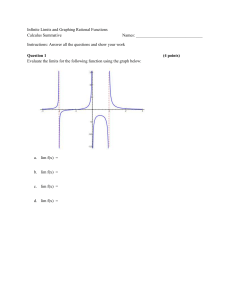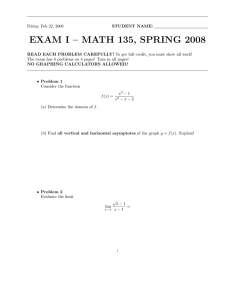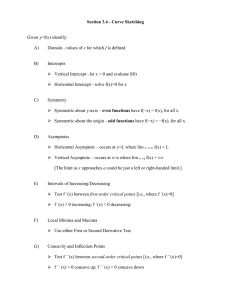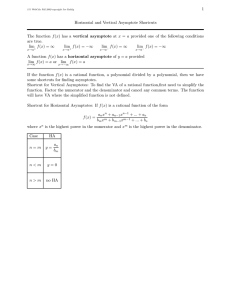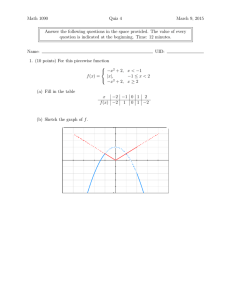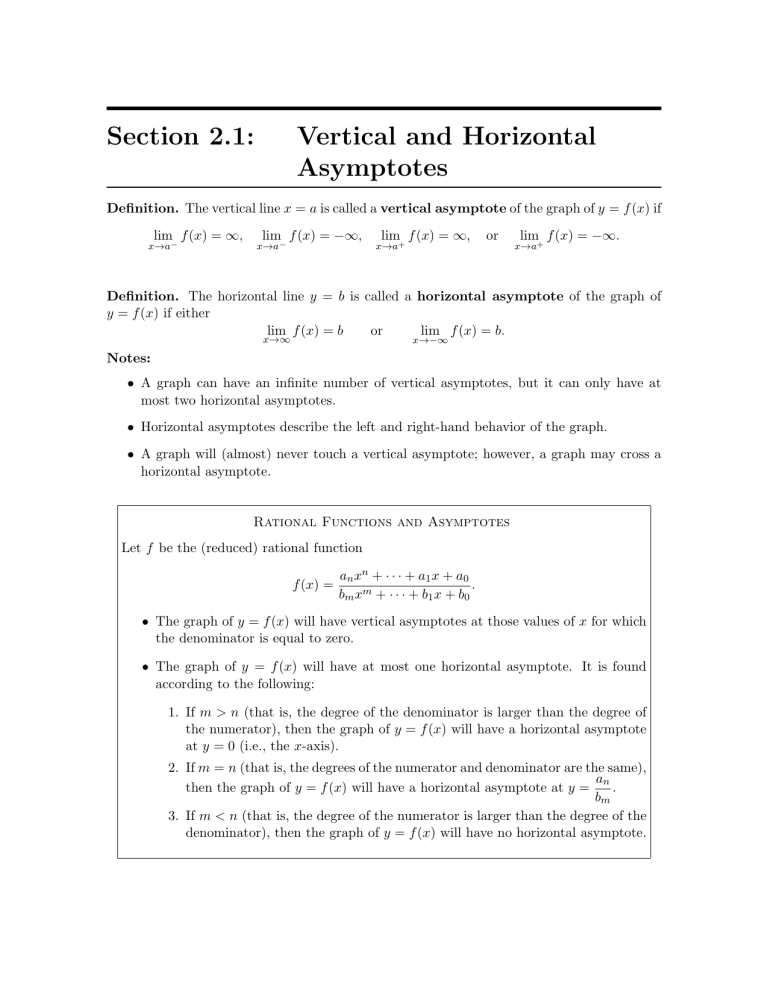
Section 2.1: Vertical and Horizontal Asymptotes Definition. The vertical line x = a is called a vertical asymptote of the graph of y = f (x) if lim f (x) = ∞, x→a− lim f (x) = −∞, x→a− lim f (x) = ∞, x→a+ or lim f (x) = −∞. x→a+ Definition. The horizontal line y = b is called a horizontal asymptote of the graph of y = f (x) if either lim f (x) = b or lim f (x) = b. x→∞ x→−∞ Notes: • A graph can have an infinite number of vertical asymptotes, but it can only have at most two horizontal asymptotes. • Horizontal asymptotes describe the left and right-hand behavior of the graph. • A graph will (almost) never touch a vertical asymptote; however, a graph may cross a horizontal asymptote. Rational Functions and Asymptotes Let f be the (reduced) rational function f (x) = an xn + · · · + a1 x + a0 . bm xm + · · · + b1 x + b0 • The graph of y = f (x) will have vertical asymptotes at those values of x for which the denominator is equal to zero. • The graph of y = f (x) will have at most one horizontal asymptote. It is found according to the following: 1. If m > n (that is, the degree of the denominator is larger than the degree of the numerator), then the graph of y = f (x) will have a horizontal asymptote at y = 0 (i.e., the x-axis). 2. If m = n (that is, the degrees of the numerator and denominator are the same), an then the graph of y = f (x) will have a horizontal asymptote at y = . bm 3. If m < n (that is, the degree of the numerator is larger than the degree of the denominator), then the graph of y = f (x) will have no horizontal asymptote. SECTION 2.1: 2 Example 1. VERTICAL AND HORIZONTAL ASYMPTOTES Find the vertical and horizontal asymptotes of the graph of f (x) = 3x + 1 . x2 − 4 Solution. The vertical asymptotes will occur at those values of x for which the denominator is equal to zero: x2 − 4 = 0 x2 = 4 x = ±2 Thus, the graph will have vertical asymptotes at x = 2 and x = −2. To find the horizontal asymptote, we note that the degree of the numerator is one and the degree of the denominator is two. Since the larger degree occurs in the denominator, the graph will have a horizontal asymptote at y = 0 (i.e., the x-axis). The graph of f (x) = 3x + 1 x2 − 4 is given below: Notice the graph shows the following limits: 1. 2. 3. lim f (x) = −∞ 4. lim f (x) = ∞ 5. lim f (x) = −∞ 6. x→−2− x→−2+ x→2− lim f (x) = ∞ x→2+ lim f (x) = 0 x→∞ lim f (x) = 0 x→−∞ SECTION 2.1: VERTICAL AND HORIZONTAL ASYMPTOTES Example 2. Find the vertical and horizontal asymptotes of the graph of 3 f (x) = 4x2 . x2 + 8 Solution. The vertical asymptotes will occur at those values of x for which the denominator is equal to zero: x2 + 8 = 0 x2 = −8 √ x = ± −8 Since √ −8 is not a real number, the graph will have no vertical asymptotes. To find the horizontal asymptote, we note that the degree of the numerator is two and the degree of the denominator is also two. Since the degrees are the same, the graph will have a horizontal asymptote at y = 41 = 4. The graph of f (x) = 4x2 x2 + 8 is given below: Notice the graph shows the following limits: 1. 2. lim f (x) = 4 x→∞ lim f (x) = 4 x→−∞ SECTION 2.1: 4 VERTICAL AND HORIZONTAL ASYMPTOTES Example 3. Find the vertical and horizontal asymptotes of the graph of f (x) = x2 − 2x + 2 . x−1 Solution. The vertical asymptotes will occur at those values of x for which the denominator is equal to zero: x−1=0 x=1 Thus, the graph will have a vertical asymptote at x = 1. To find the horizontal asymptote, we note that the degree of the numerator is two and the degree of the denominator is one. Since the larger degree occurs in the numerator, the graph will have no horizontal asymptote. The graph of f (x) = x2 − 2x + 2 x−1 is given below: Notice the graph shows the following limits: 1. 2. lim f (x) = −∞ 3. lim f (x) = ∞ 4. x→1− x→1+ lim f (x) = +∞ x→∞ lim f (x) = −∞ x→−∞ SECTION 2.1: VERTICAL AND HORIZONTAL ASYMPTOTES 5 Result. A logarithmic function will have a vertical asymptote precisely where its argument (i.e., the quantity inside the parentheses) is equal to zero. Example 4. Find the vertical asymptote of the graph of f (x) = ln(2x + 8). Solution. Since f is a logarithmic function, its graph will have a vertical asymptote where its argument, 2x + 8, is equal to zero: 2x + 8 = 0 2x = −8 x = −4 Thus, the graph will have a vertical asymptote at x = −4. The graph of f (x) = ln(2x + 8) is given below: Notice the graph shows the following limits: 1. 2. lim f (x) = −∞ x→−4+ lim f (x) = +∞ x→∞ SECTION 2.1: 6 VERTICAL AND HORIZONTAL ASYMPTOTES EXERCISES Find the vertical and horizontal asymptotes of the following functions: 1. f (x) = 4x + 5 4x2 − 9 5. f (x) = 4x2 − 3 2x2 − 3x + 1 2. f (x) = 3x + 1 x−2 6. f (x) = 4x x3 + 8 3. f (x) = 2x − 1 x2 + 4 7. f (x) = ln(3x − 9) 4. f (x) = x3 + 2x + 1 x2 − x − 12 8. f (x) = ln(2x + 3) 9. For the function y = f (x) graphed below, find the following limits: (a) (b) lim f (x) = (c) lim f (x) = (d) x→−2− x→−2+ lim f (x) = (e) lim f (x) = (f) x→2− x→2+ lim f (x) = x→−∞ lim f (x) = x→∞ SECTION 2.1: VERTICAL AND HORIZONTAL ASYMPTOTES 7 10. For the function y = f (x) graphed below, find the following limits: (a) (b) lim f (x) = (c) lim f (x) = (d) x→−1− x→−1+ lim f (x) = (e) lim f (x) = (f) x→1− x→1+ 11. For the function y = f (x) graphed below, find the following limits: (a) lim f (x) = x→−∞ (b) lim f (x) = x→∞ lim f (x) = x→−∞ lim f (x) = x→∞ SECTION 2.1: 8 VERTICAL AND HORIZONTAL ASYMPTOTES 12. For the function y = f (x) graphed below, find the following limits: (a) (b) lim f (x) = (c) lim f (x) = (d) x→0− x→0+ lim f (x) = x→−∞ lim f (x) = x→∞ ANSWERS 1. VA: x = ±3/2; HA: y = 0 6. VA: x = −2; HA: y = 0 2. VA: x = 2; HA: y = 3 7. VA: x = 3 8. VA: x = −3/2 3. VA: none; HA: y = 0 4. VA: x = −3, x = 4; HA: none 5. VA: x = 1/2, x = 1; HA: y = 2 10. (a) +∞ (b) −∞ (c) +∞ (d) −∞ (e) 0 (f) 0 11. (a) 3 9. (a) −∞ (b) +∞ (c) +∞ 12. (a) +∞ (d) −∞ (b) +∞ (e) 2 (c) +∞ (f) 2 (d) +∞ (b) −3
